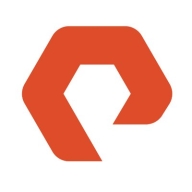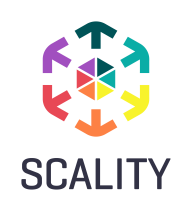

![SwiftStack [EOL] Logo](https://images.peerspot.com/image/upload/c_scale,dpr_3.0,f_auto,q_100,w_64/rCrJ5QMmvucDdhnMyyNUFbAd.jpeg?_a=BACAGSDL)
Find out what your peers are saying about Red Hat, Dell Technologies, Nutanix and others in File and Object Storage.


| Company Size | Count |
|---|---|
| Small Business | 11 |
| Midsize Enterprise | 11 |
| Large Enterprise | 21 |
| Company Size | Count |
|---|---|
| Small Business | 3 |
| Midsize Enterprise | 1 |
| Large Enterprise | 12 |
| Company Size | Count |
|---|---|
| Small Business | 3 |
| Midsize Enterprise | 2 |
| Large Enterprise | 3 |
FlashBlade is the industry’s most advanced scale-out storage for unstructured data, powered by a modern, massively parallel architecture to consolidate complex data silos (like backup appliances and data lakes) and accelerate tomorrow’s discoveries and insights.
Scality RING is the scalable and resilient object storage solution designed for modern workloads, providing seamless data protection against evolving cyber threats.
Scality RING leverages S3 object storage to meet unpredictable demands with a patented MultiScale Architecture that offers limitless scalability across capacity, performance, and more. It delivers end-to-end cyber resilience with CORE5 for ransomware protection, while its cloud-style economics and intuitive management empower enterprises to accelerate AI initiatives and optimize cloud deployments. Its flexibility is ideal for service providers managing extensive data needs.
What are the key features of Scality RING?Scality RING is extensively implemented in backup solutions across industries, supporting platforms like Veeam and CommVault. It aids in storage expansion and management of large data volumes alongside multi-site architectures. While not leading in AI spaces due to performance constraints, there's potential with faster disk support. It's also used in archives, binary lakes, multimedia services, and AI data lakes.
SwiftStack [EOL] offers robust cloud integration, rapid deployment, and hardware-agnostic capabilities, making it a preferred choice for organizations needing scalable and flexible storage solutions. It supports a variety of storage needs from object storage to enterprise-grade backup systems.
SwiftStack [EOL] is recognized for its seamless cloud integration and platform independence, enabling rapid deployment and superior scalability. Its metadata search, proxyFS, and 1space feature enhance versatility and backup efficiency. SwiftStack Controller provides an enhanced management experience with easy system upgrades and performance monitoring. While the management UI and ProxyFS maturity have room for improvement, users seek more organized interfaces and better REST API support. Enhancements in erasure coding configurations and data archiving, along with improved client library integrations, are highlighted needs. The demand for NFS integration improvements and options for data movement between storage policies is noted.
What are the key features of SwiftStack?SwiftStack [EOL] is implemented in industries as a backup platform for Commvault and Veeam, cloud storage similar to Amazon S3 or Azure Blob. It's essential for SaaS platforms, data sharing in research, preproduction object storage, data center operations, and archival management for OpenStack Swift servers in educational and research institutions.
We monitor all File and Object Storage reviews to prevent fraudulent reviews and keep review quality high. We do not post reviews by company employees or direct competitors. We validate each review for authenticity via cross-reference with LinkedIn, and personal follow-up with the reviewer when necessary.